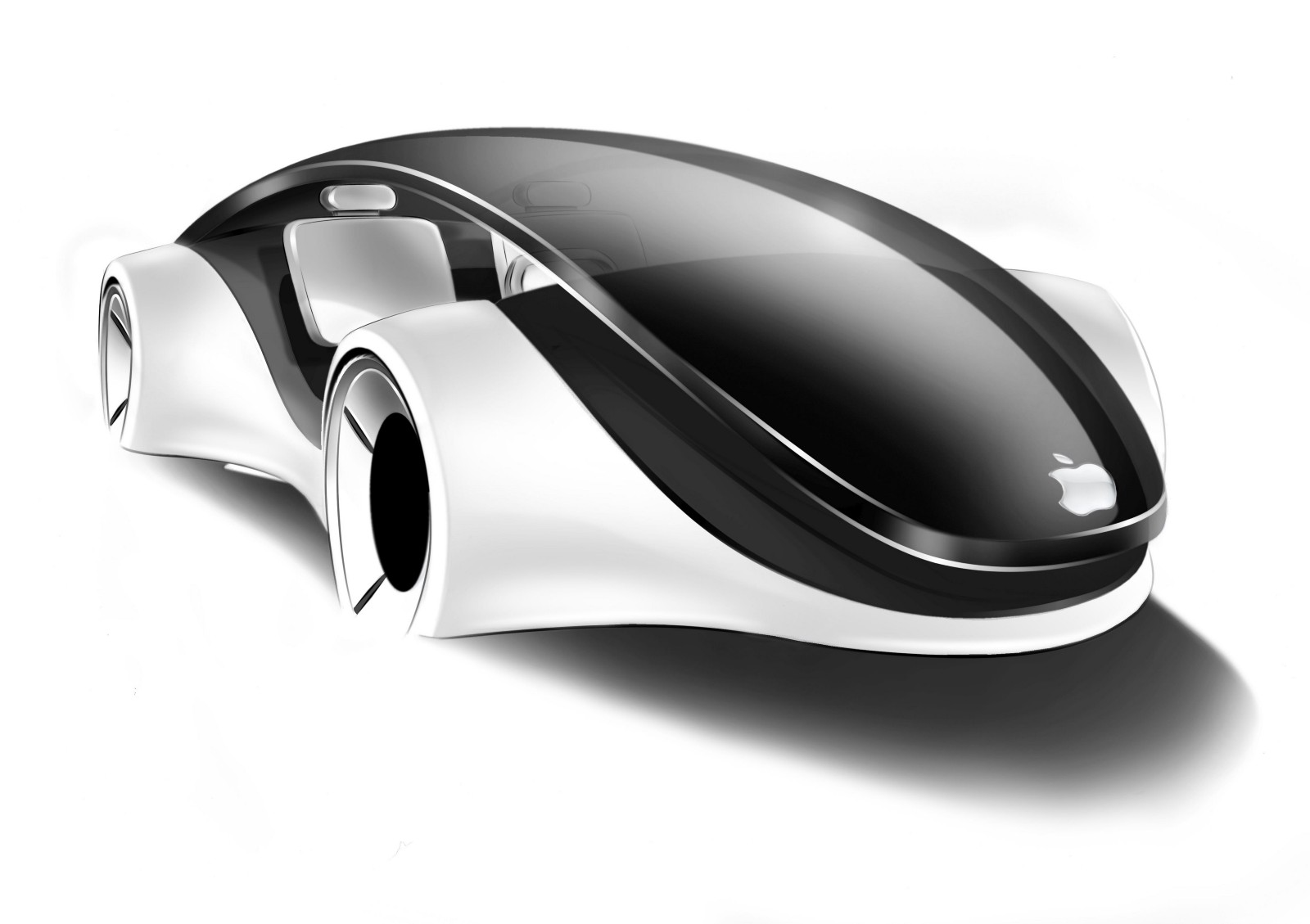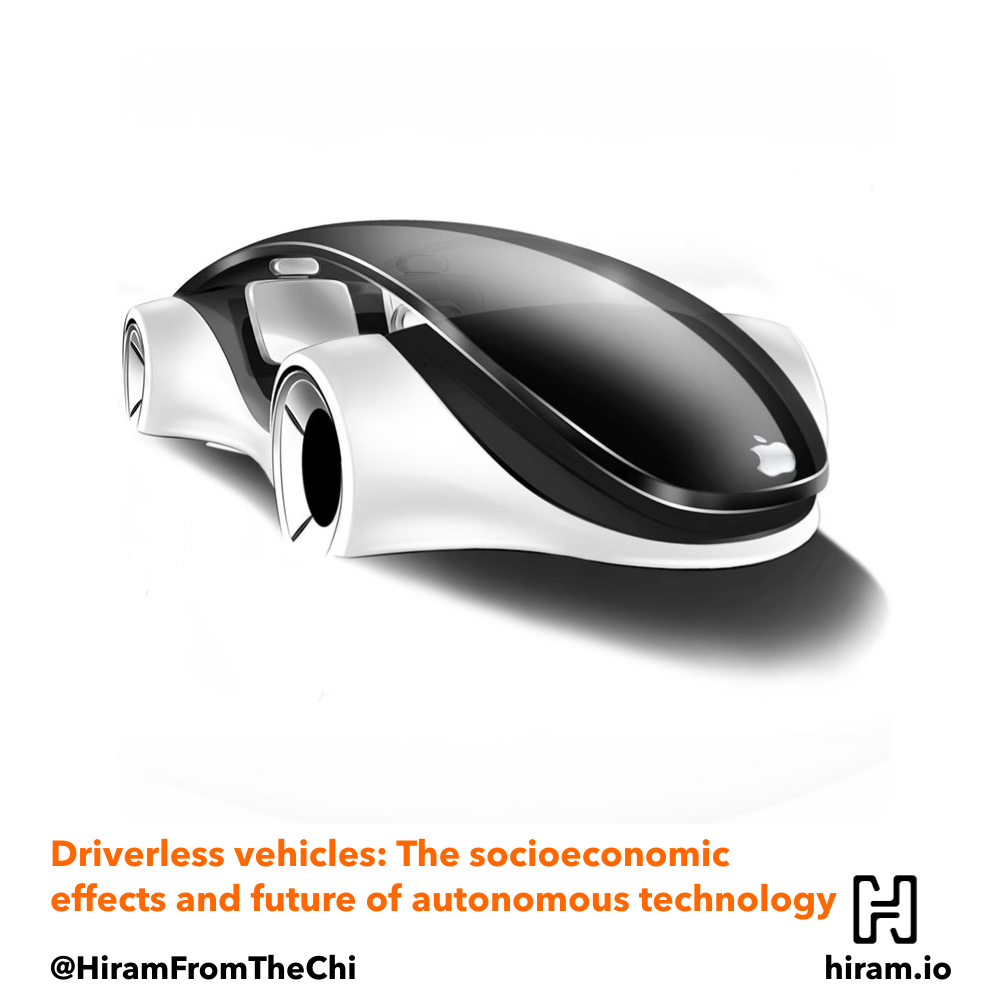Table of Contents
What is autonomous technology and why does it matter?
An overview of the ethics questions involved
The internet, hacking, and other problems
The big players in the autonomous tech space
Note: This article was originally published as an essay for an ethics class. I have decided to keep it in the same format given the sources used. It was originally written sometime in 2016. Quite interesting to observe similarities, differences, and growth in just a few years when it comes to driverless cars and autonomous technology.
Prompt: Some researchers believe that self-driving cars should be completely driverless and would lead to a sharp reduction in the number of traffic accidents and auto-related deaths. However, others think some driver involvement should be required in self-driving cars, and are concerned about the associated liability issues. How do you see technology changing roadway safety?
Background
Thousands of years ago, humans roamed the earth on nothing but bare feet. Hundreds of years ago, we rode horses and carriages, even trains. Then, Henry Ford and the automobile came along to pave the way for one of today’s most common ways of transportation. Trains have withstood the test of time, and so have cars. We now even roam the skies. It seems as though cars are here to stay, and for good. Recent major advances in technology have given way to autonomous vehicles, which are becoming increasingly prevalent in our lives. It is unclear, however, where the road of driverless cars is headed towards.
The socioeconomic effects of solely their introduction and small-scale integration into society have yielded numerous benefits. These benefits range from time spent traveling, to natural resource management, to a decrease in deaths, and beyond. As with any new technological advancement, however, there have also been opposing challenges.
These include but are not limited to:
- a decrease in jobs
- an increase in security and privacy concerns
- and of course, legality issues, for there is no set precedent regarding autonomous vehicles
Though we have only scratched the surface, this article aims to address and discuss costs, benefits, major players in the industry and their visions, and ultimately spark thought into the ethical dilemmas that autonomous vehicles propagate so that we may ultimately reap the benefits and continue to push forward in order to apply ourselves towards creating a safe, innovative, and revolutionary future.
What is autonomous technology and why does it matter?
At first glance, the notion of driverless cars may frighten us. To not have any control over our own cars seems almost out of a futuristic Will Smith screenplay. And in some elements, it is. So many times we have seen or heard of cars that drive themselves, or cars that fly, or cars that know exactly where they are going and maybe even speak to us as if they were a person. Well, today’s autonomous automobiles are quite intelligent. And they do not always need a steering wheel, brake pedal or accelerator pedal, because, well, “they don’t need them,” notes Google. To not have control over your own car seems almost surreal, but it is the way of the industry.
These cars are currently legal in Nevada, Florida, California, Michigan, and Washington D.C. They are looking to continue their expansion across the country as more laws are passed guaranteeing their presence and vehicle testing is incorporated into our streets. Because of this surge in eminence, the debate over driverless cars has surfaced in its increased attention towards cars, even though autonomous systems and artificial intelligence technologies have been around for decades. Predictably, ethical dilemmas have risen with along with it. Issues regarding privacy, security, software, and legalities remain.

The statistics
There are 5.5 million car crashes per year in the United States. That is one death every 15 minutes or roughly 88 deaths per day. Someone, every day, is losing a loved one to a preventable accident. Unsurprisingly, 81% of those car crashes are caused by human error (Johnson, 2014). Once again: preventability.
To put things into perspective, Google’s self-driving cars have successfully driven 700,000 miles without an accident. The average person drives about 15,000 miles per year. This means that Google cars have been safe for the equivalent of approximately 47 years straight. But perhaps the most common unanswered question remains: Who is liable in the event of a driver-less car accident?
An overview of the ethics questions involved
This is a very fair question. After all, the car would be programmed to calculate someone’s life, or lives, over someone else’s. How could we let a machine determine this? The system will analyze and evolve as it grows, but primarily, it was coded that way. So, would the programmers be responsible? If no one was driving it, there is no driver to blame, as there is now. Still, there is money coming out of someone’s pocket, isn’t there? Jail time? How? All of these questions are extremely valid and need to be taken into consideration.
Who is to say that we will ever come up with reasonable answers to these questions? A research paper published by the Massachusetts Institute of Technology claims that the cars’ “moral algorithms will need to accomplish three potentially incompatible objectives: being consistent, not causing public outrage, and not discouraging buyers” (Bonnefon, Shariff, Rahwan, 2013).
The benefits
Think of it this way: By removing the largest part of the equation (a human driving), there will be drastically less autonomous car accidents given that at least four out of five accidents can be averted. Thus, computers actually make for an ideal motorist. In fact, believe it or not, airplanes are mostly self-driven. Pilots are predominantly there for the takeoff and landing, as well as to offer general peace of mind to the passengers. Answers to these burning questions, though extremely difficult to answer, may or may not come to fruition when and if the time comes.
Additional benefits to autonomous cars would include the two words we all know synonymously: time and money. With driverless cars, speed limits would be increased, and thus commuting would take less time, whether from home to work or on a cross-country road trip. Another factor in this increased efficiency would be space, as gaps between cars would be less and would decongest traffic greatly, given that the cars are constantly calculating and communicating with each other and ultimately knowing what each car is doing at all times to avoid accidents. This would result in faster speeds and more cars on the road at the same time, all while keeping traffic low.

More cars on the road at the same time at or around double the speed limit would save an incredible amount of cumulative time commuting, both personally and commercially. If just 20% of all cars in the US were autonomous, there would be approximately 21,700 lives saved per year. There would be 4,220,000 fewer crashes. Savings would amount to approximately $109.7 billion yearly. We would save 2,772 million hours traveling annually, and save 724 million gallons of gas in the process (Johnson, 2015).
There are also external, less explicit benefits, such as dreaded traffic violations. Because an autonomous car would not be able to break traffic laws, police departments could dedicate their resources to more serious crimes, rather than focusing on parking tickets, speeding tickets, and other relatively insignificant road-related defilements.
Another implicit use of autonomous cars would be for the elderly or disabled. Cars that have the ability to drive themselves would reduce worry for friends and family members, as well as allow for users who need help to gain some more independence.
The disadvantages
Despite these benefits, one of the most illuminating concerns regards the price of these cars, and rightfully so. According to the National Automobile Dealers Association, the average American spends approximately $30,000 on a new car or light truck. By contrast, Interest.com ‘s 2013 Car Affordability Study claims that the average American can only afford to spend about $20,000 on a car. However, when people begin to buy the technology that makes cars autonomous, the prices will decrease because the costs will also decrease due to more purchasing power as economies of scale are inevitably activated in the market.
Ironically, in order to reach that point, more people must buy the expensive cars at those higher rates in order for the prices to come down. The key takeaway here, though, is that there are different sensors, lasers, cameras, and algorithms in the technologies that are better and worse (and thus cheaper and more expensive) to implement into vehicles.
The numbers
The specifics of the various technologies are beyond the scope of this article, but it is crucial to know because they heavily influence costs, and in turn, sticker price. At the current rates, IHS Automotive calculates that annual sales between 2025 and 2035 will jump from 230,000 to 11.8 million. That equates to about nine percent of the world’s automobile population. Seven million of those 11.8 million vehicles will rely on a combination of driver input and autonomous control (rather than fully autonomous), with the remaining 4.8 million vehicles relying entirely on computers to get from point A to point B.
Combined with vehicles from previous model years, IHS also projects that there will be 54 million autonomous vehicles on the road by 2035. By 2050, autonomous vehicle sales will have surpassed traditional car sales. Something that has been advocated for is what is referred to as “permissionless innovation”, which is “has been the primary driver of entrepreneurialism and economic growth in many sectors of the economy” (Thierer, 2014).
The internet, hacking, and other problems
The internet is cited as the most notable example of this given the far-reaching socio-economic benefits it has provided. Is the internet perfect? Far from it. Are there hindrances associated with it? Of course. But it has effectively revolutionized our lives. Thierer further argues that “As an open and lightly regulated platform, the Internet allows entrepreneurs to try new business models and offer new services without seeking the approval of regulators beforehand. Its very architecture is premised on this style of innovation” (Thierer, 2014).
There is also, of course, the idea that computers cannot be distracted. Or can they? Maybe the word distracted can be used synonymously with hacked. Computers can, of course, be hacked. In a 2015 article published by Wiredmagazine, a couple of hackers remotely took over a Jeep as an experiment to raise awareness about the loopholes in cars with built-in software, which resulted in Chrysler issuing a recall of 1.4 million cars as a result of this trial. However, there are many ways to tackle this issue. One suggestion that researchers have stated is keeping cars’ control circuits separate from the Internet ones (Pogue, 2015).
This would effectively allow the incorporation of technology while still securing the driver and/or passengers’ safety by disallowing any sort of hacking to be a possibility whether the car is on the road or not. Norton also advises that you educate yourself about wireless systems, remote shutdown, after-market devices, among other strategies for protecting you and your car’s security.
Intel advocates for the establishment of a secure authentication system that ensures the various connected systems in a car are communicating with one another rather than an unknown, outside source. Intel also recommends increased security measures throughout the supply chain to prevent tampering or counterfeit parts entering a vehicle (Huddelston Jr., 2015). Many of the responsibilities regarding these issues, because of the nature of the machinery, will inevitably fall in large part to the automobile manufacturers.

Can humans and self-driving vehicles coexist?
Perhaps one of the most mind-boggling dilemmas experts are confronting is the incorporation of the automobiles. The ‘how’ aspect remains a mystery. Down to its basics, there are two possible options: Merge the cars with traditional vehicles in an incremental fashion that would take years to reach ‘optimal’ levels (I say ‘optimal’ because we are really not aware as to what an ‘optimal’ number of each type of car would be), or completely assimilate the not-so-futuristic cars to the point where our traditional cars are outlawed, and eventually become scrap metal.
There are conflicting ideas that autonomous vehicles and traditional vehicles can peacefully coexist. At Nvidia’s GPU Technology Conference in San Jose, Elon Musk declared that “In the distant future, people may outlaw driven cars because it’s too dangerous” (Hof, 2015). When asked about government regulation, Musk predicts that regulators will lag about one year behind the technology, which is expected to be fully running and near-perfect for roads in 2018.
This is not to say that our roads will be swarming with Tesla’s driverless cars, but rather to see a large increase in what companies are aiming for. “The point at which it becomes statistically clear that an autonomous car is safer, I think, regulators will be comfortable with allowing it,” Musk answered (Korosec, 2015). Musk has also been asked multiple times about his projections and timelines for various projects. His timeline has shortened for how long we should await autonomous vehicles.
The big players in the autonomous tech space
Despite the popular belief that research vehicles are consumer-ready, the path from research to production is long — and yet alternative deployment models will blur testing and operation in a way that merits more contextual regulation (Smith, 2013). Though Tesla’s project was conjectured at a range from five to six years, it has now been cut down to roughly two years, approximately a third of the expected time period. We can only speculate that future timelines are also completed earlier than expected.
While Tesla and Google remain the predominant players in the sovereign car game, there are quite a number of other companies that have taken on the challenges that come with testing and incorporating driverless cars. Google does most of its testing in California with proximity near their headquarters in Mountain View, but it has expanded tremendously. The technology has also improved weekly. The autonomous technology Google possesses can now recognize pedestrians and cyclists, detect hundreds of objects simultaneously and even “read” stop signs (Strohm, 2015).

Mercedes-Benz has also put a stamp on autonomous transport with the unveiling of the F015 concept car. Dieter Zetsche, CEO of Daimler AG, the manufacturer of Mercedes-Benz cars, said however, “The car is growing beyond its role as a mere means of transport and will ultimately become a mobile living space,” and was originally meant for the testing of their technologies rather than to bring it into their marketplace. Projections for market penetration are likely to change, however, as the market becomes more competitive and less saturated due to companies’ new adaptations.
The UK company Delphi Automotive is similar to Google in that they have had much success in their cars recognizing objects beyond just other vehicles. Delphi’s main boaster about their cars is the “unexpected obstacles,” feature such as a cyclist or another vehicle pulling in front of the self-driving car (Strohm, 2015).
Considerations and projections
Kristen Kinley, global communications manager of the electronics and safety division for Delphi Automotive, the big auto parts manufacturer, says that there are many years until drivers will be able to surrender complete control of their cars because they need to be fail-proof. This may not necessarily be the case, however. Cars today are not fail-proof, and though we do have “control” over our cars, there are still many flaws.
Yet, we drive millions of miles every day, knowing the risks associated with driving, particularly at higher speeds. With this said, this should not “be a reason to prevent consumer access to autonomous vehicle technology,” states John Villasenor, a nonresident senior fellow in the Department of Governance Studies and the Center for Technology Studies at Brookings.

Bradley Sturtz, manager of corporate communications for Audi, contemplates a hefty 20–30 years before fully automated vehicles are a reality (Strohm, 2015). “To have the car understand every single possibility is a massive challenge,” he notes. Despite hesitations, in January of 2015, Audi sent a driverless model A7 from Palo Alto, California, to Las Vegas, Nevada with over 560 miles driven one way. The car arrived without a scratch.
One of the lesser-known projects revolves around Titan, Apple’s driverless vehicle project. While many believed the endeavor to be a myth (and there are still many uncertainties about it), Ford CEO Mark Fields holds it to be true (IT PRO, 2016). Chris Porritt, former vice president of vehicle engineering for Tesla and former chief engineer for Aston Martin, have also been in the environment surrounding an Apple car rumor. However, due to Apple’s extensive efforts and lengths to protect their secrets, a (presumably) all-white car with an iPod scroll wheel as the steering wheel remains just that — a rumor (though there have been alleged sightings).
Conclusion
Despite any sort of shortcomings and uncertainties surrounding autonomous vehicles and their incorporation, the technologies are here to stay. The technologies used are still primitive in relation to the ambitions of the driverless car industry, but projections and speculations are nothing if not combined with action. Some researchers argue that self-driving cars do not necessarily have to be perfect, because even with their imperfections they are still much safer than our current cars today. And testing is only so effective. Concrete steps must be taken to fully assimilate autonomous cars into our everyday lives so that we (and the cars themselves) can begin to better understand real-life scenarios.
If you have any thoughts, questions, or comments around autonomous technology, I'd love to hear them. Find me online:
- Web: hiram.io
- Rising Tide (blog): hiram.io/blog
- LinkedIn: @hiramfromthechi
- Twitter/X: @hiramfromthechi
- Medium: @hiramfromthechi
- Mastodon: @hiramfromthechi@mastodon.social

